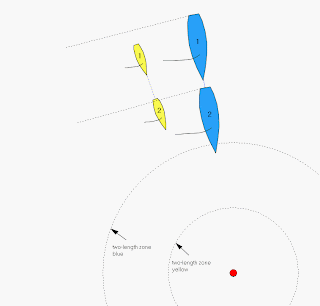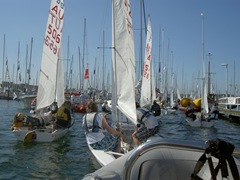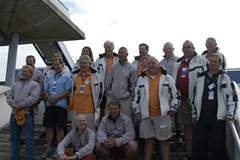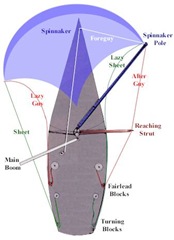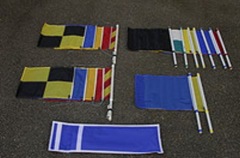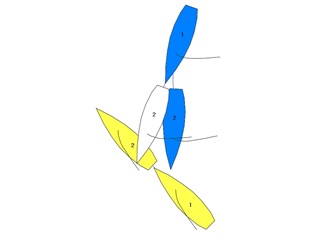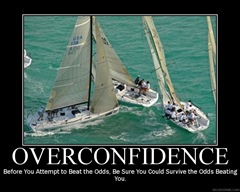To catch up, you can read
part one here.The on-the-water part of the seminar was done during a actual match race event, in my case the Lugano Match Race act 2, a Grade 3 event.
This means that all the participants together with a chairman and two instructors, are the complete umpire team. All task normally performed at an event, are to be done by this group. Starting from an initial meeting going over the SI, getting specific tasks assigned (I had to keep track off and look after Umpire Boats) to preparing schedules and speaking at debriefs with the sailors. Because of the 'seminar' situation a couple of things were added to this; assignments with an assessor and time for debriefing and stuff like that. Otherwise a normal event with sailors who came for the event and wanted to win. The boats were Streamline, a very fast and quick turning keel boat, with spinnaker. Not the most ideal match race boat for a seminar, but certainly one which is used in more match race events around the world.
The wind was very light the first day but we could get a couple of flights in, that first afternoon. The second day was even worse, and we had to wait a long time before we could do some racing. Everybody was fearing we would not be amble to complete the assessments nor the match racing, but luckily the final day there was a good breeze and we could get things finished. If the wind wouldn't have come, the assessments would not have been completed, which meant that we needed another one at a different event.
It felt like your every move was watched and scrutinize. That may be an exaggeration, but the umpire assessment is definitely more than those ten minutes umpiring on the water. It also is based on your teamwork, attitude and general performance during the whole event. Leave it to yours truly, to go and pick a fight with one of the instructors about - you guessed it - boat assignments. And doing it in public in a group session, was not a good idea. I had a valid bone to pick, but should have done so in private with the instructor. Certainly a learning experience. We talked about it and I'm glad it didn't eventually influenced the decision to let me pass.
So umpiring at a seminar is different from 'normal' umpiring, that there is this third person aboard watching you. In order to perform as best as I could, I prepped myself to concentrate solely on the umpiring, try to forget about the assessor. "Relax, Jos, you can do this, relax, do what you do, the assessment will come later, relax." I repeated in my mind. Fortunately we were the second match umpires. So we started shadow-umpiring for the first match.
Let me explain: 'shadow umpiring' is doing all the things umpires do, but without following the boats and - of course - not answering any calls. It is a great way to get your mind into 'gear', concentrating on the umpiring, getting used to your fellow umpire. Because we were with 11 participants and only 8 of us had a job in any flight, some of us had to wait on the starting vessel in between. We were encouraged to do shadow-umpiring from there. Because of this, I soon was able to 'forget' about the assessor and concentrate on the match. In all my matches I was able to perform adequately, phew....

One of the things which was "forgotten" at this seminar was anything to do with "winging". No feedback on how the wing boat operated, no clues on where to be or what to say. More like, that is something you should know already, and we don't want to waste time. I think that is a mistake. A good wing can be very valuable for umpires and sometimes is crucial in making the right decision. A missed opportunity as far as I'm concerned.
As to the results; from the eleven participants nine managed to pass the written test, but only three passed the Umpire 'on the water' assessment. Seems like a very meager result, doesn't it? With that much effort by everybody, not to mention costs involved... only three?
I didn't have the opportunity to umpire with everyone and my own assessments have only gone as far as looking at National level umpires, but with one exception, I agreed with the result. Even with a good knowledge of the rules, sufficient skill to do the umpiring and keep on top of teamwork, I still felt like a beginner on the International level, and in need of learning a lot more.
Again, an Umpire assessment is a lot more then that part you do on the water. If you look at the assessment form, you are graded also on all other aspects of being an umpire at an international event. Who knows, perhaps standing up to the instructor wasn't such a bad thing after all?

To all future participants of IU Seminars my advice is to use any and all opportunities to practice. Whenever you are on the water, even just watching a fleet race, start shadow umpiring. Follow a boat for a couple of minutes while they round a mark and say what you would say if umpiring. Of course you should read the manual, study the call book and the rules, but foremost practice! Use video found on the Internet, watch television, anything. You can even do it in the classroom: Two people do blue and yellow with the models on the board, and two umpires speak and decide.
Once you've mastered the rules and communication automatically, you can concentrate on anticipation - what will happen next - and be in the right position for the next call.
Oh, if at all possible, do some match racing yourself!
This concludes my notes on my IU Seminar. Please don't hesitate to mail me, if you have specific questions.
 Alinghi overturned,with crew and support -staff making her ready to be righted.
Alinghi overturned,with crew and support -staff making her ready to be righted. Holmatro and BT getting ready for the final race of the day
Holmatro and BT getting ready for the final race of the day











